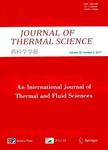Inverse Problem and Variation Method to Optimize Cascade Heat Exchange Network in Central Heating System
Inverse Problem and Variation Method to Optimize Cascade Heat Exchange Network in Central Heating System作者机构:College of Architecture and Environment Sichuan University Department of Building Science Tsinghua University
出 版 物:《Journal of Thermal Science》 (热科学学报(英文版))
年 卷 期:2017年第26卷第6期
页 面:545-551页
核心收录:
学科分类:080702[工学-热能工程] 08[工学] 0807[工学-动力工程及工程热物理] 081404[工学-供热、供燃气、通风及空调工程] 0814[工学-土木工程]
基 金:financed by National Key Research and Development Program of China(2016YFB0901405) National Natural Science Foundation of China(51706148) Sichuan Science and Technology Program(2017JY0333)
主 题:District heating Heat exchanger Thermal performance optimization Inverse problem Lagrange variation
摘 要:Urban heating in northern China accounts for 40% of total building energy usage. In central heating systems, heat is often transferred from heat source to users by the heat network where several heat exchangers are installed at heat source, substations and terminals respectively. For given overall heating capacity and heat source tempera- tore, increasing the terminal fluid temperature is an effective way to improve the thermal performance of such cascade heat exchange network for energy saving. In this paper, the mathematical optimization model of the cas- cade heat exchange network with three-stage heat exchangers in series is established. Aim at maximizing the cold fluid temperature for given hot fluid temperature and overall heating capacity, the optimal heat exchange area dis- tribution and the medium fluids' flow rates arc determined through inverse problem and variation method. The preliminary results show that the heat exchange areas should be distributed equally for each heat exchanger. It al- so indicates that in order to improve the thermal performance of the whole system, more heat exchange areas should be allocated to the heat exchanger whore flow rate difference between two fluids is relatively small. This work is important for guiding the optimization design of practical cascade heating systems.



